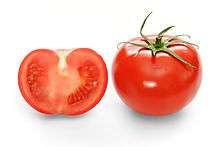Origins of North Indian and Pakistani foods

Potato (Aloo)

Tomato (Tamatar)
.jpg)
Okra (Bhindi)
Cauliflower (Phool Gobhi)

Taro (Arbi)
Most of the food items that define modern North Indian and Pakistani cooking have origins inside the Indian subcontinent though many foods that are now a part of them are based on fruits and vegetables that originated outside the Indian subcontinent.
Vegetable origins
| Vegetable | Hindi name | Origin | Likely time of introduction | Notes |
|---|---|---|---|---|
| Bitter Melon | Karela | Unknown | Unknown | |
| Cabbage | Band/Patta Gobhi | Mediterranean Region | Derived from Wild Mustard | |
| Calabash | Lauki/ghiya | India | ||
| Cauliflower | Phool Gobhi | Cyprus or Turkey | 1500 CE | |
| Chili pepper | Mirch | Americas[1] | 1550 CE[1] | Introduced by Portuguese traders |
| Coriander | Dhania | North Africa or Southwest Asia | Unknown | Mentioned in ancient Egypt |
| Eggplant | Baingan | Native to the South Asia | ||
| Fenugreek | Methi | Middle East (possibly Iraq) | Unknown | |
| Garlic | Lehsan | Unknown (possibly North Africa) | Unknown | |
| Lemon | Neembu | South China or Northeastern India[2] | 2000-1000 BC[2] | Lemon seeds found in the Harappan Bara culture excavations indicate time of spread[2] |
| Okra | Bhindi | Highlands of Ethiopia[3] | 100-500 CE[3] | |
| Onion | Pyaaz | Unknown (Central Asia suspected) | Unknown, but present by 500 BCE[4] | Mentioned in the Charaka Samhita |
| Potato | Aaloo | South America (Peru/Bolivia) | 1600 CE | Likely introduced by Portuguese traders |
| Sweet Potato | Shakarkand | Latin America | 1600 CE) | Via Portugal |
| Taro | Arbi / Arwi/ Guhiyaan | Unknown (India, Polynesia or SE Asia) | Unknown | |
| Tomato | Tamatar | Latin America (Mexico to Peru) | 1600 CE | Likely introduced by Portuguese traders |
| Turnip | Shalgham | West Asia or Eastern Europe | 1500 BC | Very early presence in the South Asia |
| Yam | Zimikand/Suran/kachalu/banda | Africa/Asia | 7000 BCE | Different types of yams by taste, colour, size, skin, acidity |
Fruit origins
| Fruit | Local name | Origin | Likely time of introduction | Notes |
|---|---|---|---|---|
| Apple | Seb | Central Asia (Kazakhstan) | Unknown | |
| Mango | Aam | India or SE Asia | Unknown | |
| Mulberry | Shehtoot/Toot | Temperate regions worldwide | Unknown | |
| Orange | Malta/Santara | Unknown (SE Asia) | Unknown | A sweeter Indian variety was introduced by the Portuguese in Europe (ca. 15th century) |
| Plum | Aloo Bokhara | Unknown (Armenia suspected) | Unknown | |
| Tangerine | Santara | Unknown (North Africa) | Unknown |
See also
References
- 1 2 75 Exciting Vegetables For Your Garden, Jack E. Staub, Ellen Buchert, Gibbs Smith, 2005, pp. 126, ISBN 9781586852504, ... From the Americas, hot peppers were dispersed by the earliest explorers to the Iberian Peninsula ... being cultivated in both India and Africa by the sixteenth century, with three varieties growing in India by 1542 ...
- 1 2 3 Indian Archaeology in Retrospect: Protohistory, archaeology of the Harappan civilization, Shadaksharappa Settar, Ravi Korisettar, Indian Council of Historical Research, 2002, ISBN 978-81-7304-320-8, ... The only early archaeobotanical evidence for Citrus fruits comes from the Late Harappan (Bara phase) site of Sanghol in Punjab where seeds of lemon (C. limon (L.) Burm. f.) have been reported (Saraswat and Chanchala 1997). This is of great interest as these fruits are thought to have been domesticated somewhere in the area spanning from north-eastern India to south China and South-East Asia, although there remains no firm evidence for precisely where or when ... suggests that lemons diffused westwards, presumably along the Ganga Valley in the early second millennium BC. Further west, in South-West Asia, the citron (C. medical L.) occurs as early as c. 1200 BC, while the lemon arrives later in the first millennium AD ...
- 1 2 75 Exciting Vegetables For Your Garden, Jack E. Staub, Ellen Buchert, Gibbs Smith, 2005, ISBN 9781586852504, ... Ancient varieties of okra can still be found growing wild from Ethiopia to the White Nile in Egypt, and this interesting food plant is believed to have originated in Ethiopia. In the absence of any ancient Indian names for it, modern botanists believe it found its way to India ... about AD 200 ...
- ↑ 75 Exciting Vegetables For Your Garden, Jack E. Staub, Ellen Buchert, Gibbs Smith, 2005, pp. 84, ISBN 9781586852504, ... In India, as early as the sixth century BC, the famous herbal treatise Charaka-Sanhita celebrates the onion as good for the heart, the eyes, and the joints ...
Further reading
- "Domestication of plants in the Old World," Daniel Zohary and Maria Hopf, Oxford University Press, 2000.
- "History of Food," Maguelonne Toussaint-Samat, Blackwell Publishing, 1994.
- "Culture and Cuisine: A Journey Through the History of Food," Jean François Revel, Doubleday, 1982.
- "The Agrarian History of England and Wales," Edward John T. Collins, Stuart Piggott, Joan Thirsk, Cambridge University Press, 1981.
This article is issued from Wikipedia - version of the 10/16/2016. The text is available under the Creative Commons Attribution/Share Alike but additional terms may apply for the media files.